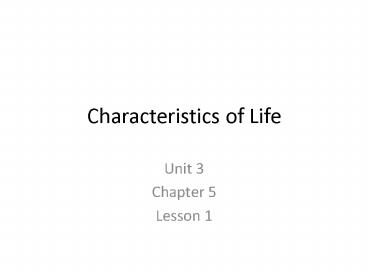Characteristics of Life - PowerPoint PPT Presentation
1 / 16
Title:
Characteristics of Life
Description:
... water -needed to obtain chemicals from surroundings, break down food, grow, ... even when conditions in surroundings change. – PowerPoint PPT presentation
Number of Views:34
Avg rating:3.0/5.0
Title: Characteristics of Life
1
Characteristics of Life
- Unit 3
- Chapter 5
- Lesson 1
2
All living things have/do
- Cellular organization
- Contain one or more cells
- Bacteria are single celled (Unicellular). The
single cell is responsible for carrying out all
functions necessary to stay alive. - In multicellular organisms the cells are
specialized to do certain tasks.
3
All living things have/do
- Chemicals of Life
- Cells contain certain chemicals
- Water
- Most abundant
- Carbohydrates
- Cells main energy source
- Proteins and lipids
- Building materials of cells
- Nucleic acids (DNA and RNA)
- Genetic material
- Carry instructions that cells need to carry out
life functions
4
All living things have/do
- Energy Use
- Organisms get energy from taking in and breaking
down materials - Metabolism is the combination of chemical
reactions through which an organism builds up or
breaks down materials. - Cells use energy to grow and repair injured parts
5
All living things have/do
- Response to Surroundings
- All organisms react to changes in their
environment - Stimulus- change in surroundings that causes an
organism to react - Example- changes in light and sounds
- Response- way the organism reacts to the stimulus
6
All living things have/do
- Growth and Development
- All living things grow and develop
- Growth is the process of becoming larger
- Development is the process of change that occurs
during an organisms life producing a more
complex organism. - Energy is used to grow and develop
7
All living things have/do
- Reproduction
- Asexual reproduction
- Involves only one parent and produces offspring
identical to parent - Example- bacteria
- Sexual reproduction
- Involves two parent cells (sperm and egg) that
combine genetic material. - Examples- mammals and birds
8
Where do Living Things Come From?
- living things come from other living things
through reproduction - -Spontaneous Generation
- -mistaken idea that living things could
come from nonliving things - -believed over 400 years ago
9
- spontaneous generation video (2 minutes)
10
Franseco Redi
- - conducted experiment in the 1600s to help
disprove spontaneous generation. - -showed that maggots came from fly eggs and
not from rotting meat - -didnt convince everyone that spontaneous
generation doesnt exist. - Redi video
11
Louis Pasteur
- gets credit for disproving spontaneous generation
in the 1800s - -boiled broth in flasks with curved necks. The
necks let air in but kept bacteria out. On the
flasks that the neck was broken bacteria was
allowed to enter.
12
- pasteur experiment
13
What do Living Things Need to Survive?
- 1) food
- -source of energy
- -autotrophs (self feeder)
- -makes own food
- -example- plants
- -heterotrophs
- -cannot make their own food eats other
organisms - -example- animals, mushrooms, slime
mold
14
What do Living Things Need to Survive?
- 2) water
- -needed to obtain chemicals from surroundings,
break down food, grow, move substances within
bodies, and reproduce - -water is vital to living things because it can
dissolve more chemicals than any other
substance - -water in the human body
- -makes up 90 of liquid part of blood
- -food dissolves in blood and is transported to
all body parts - -removes waste from cells
15
(No Transcript)
16
What do Living Things Need to Survive?
- 3) living space- includes a place to get food and
water and shelter - 4) Stable internal conditions
- -organisms must be able to keep the conditions
inside the body stable, even when conditions
in surroundings change. - -homeostasis- maintenance of stable internal
conditions - - keeps internal conditions just right for
cells to function































